Tuberculosis of the Heart: A Diagnostic Challenge
- PMID: 35894002
- PMCID: PMC9326682
- DOI: 10.3390/tomography8040137
Tuberculosis of the Heart: A Diagnostic Challenge
Abstract
Tuberculosis of the heart is relatively rare and presents a significant diagnostic difficulty for physicians. It is the leading cause of death from infectious illness. It is one of the top 10 leading causes of death worldwide, with a disproportionate impact in low- and middle-income nations. The radiologist plays a pivotal role as CMR is a non-invasive radiological method that can aid in identifying potential overlap and differential diagnosis between tuberculosis, mass lesions, pericarditis, and myocarditis. Regardless of similarities or overlap in observations, the combination of clinical and certain particular radiological features, which are also detected by comparison to earlier and follow-up CMR scans, may aid in the differential diagnosis. CMR offers a significant advantage over echocardiography for detecting, characterizing, and assessing cardiovascular abnormalities. In conjunction with clinical presentation, knowledge of LGE, feature tracking, and parametric imaging in CMR may help in the early detection of tuberculous myopericarditis and serve as a surrogate for endomyocardial biopsy resulting in a quicker diagnosis and therapy. This article aims to explain the current state of cardiac tuberculosis, the diagnostic utility of CMR in tuberculosis (TB) patients, and offer an overview of the various imaging and laboratory procedures used to detect cardiac tuberculosis.
Keywords: irregular thickening of pericardium; magnetic resonance imaging; transmural mesocardial and epicardial fat late enhancement; tuberculous myopericarditis.
Conflict of interest statement
The authors declare no conflict of interest.
Figures
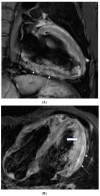
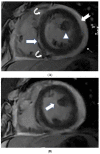


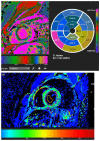
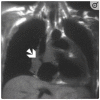

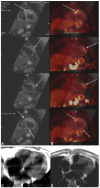
Similar articles
-
Speckle tracking imaging in inflammatory heart diseases.Int J Cardiovasc Imaging. 2018 May;34(5):787-792. doi: 10.1007/s10554-017-1284-y. Epub 2017 Nov 27. Int J Cardiovasc Imaging. 2018. PMID: 29181826
-
Myopericarditis, as the first sign of rheumatoid arthritis relapse, evaluated by cardiac magnetic resonance.Inflamm Allergy Drug Targets. 2013 Jun;12(3):206-11. doi: 10.2174/1871528111312030008. Inflamm Allergy Drug Targets. 2013. PMID: 23547732
-
Multimodality imaging evaluation of Chagas disease: an expert consensus of Brazilian Cardiovascular Imaging Department (DIC) and the European Association of Cardiovascular Imaging (EACVI).Eur Heart J Cardiovasc Imaging. 2018 Apr 1;19(4):459-460n. doi: 10.1093/ehjci/jex154. Eur Heart J Cardiovasc Imaging. 2018. PMID: 29029074
-
Diagnostic and prognostic role of cardiac magnetic resonance in acute myocarditis.Heart Fail Rev. 2019 Jan;24(1):81-90. doi: 10.1007/s10741-018-9724-x. Heart Fail Rev. 2019. PMID: 30033478 Review.
-
Imaging the itis: endocarditis, myocarditis, and pericarditis.Curr Opin Cardiol. 2019 Jan;34(1):57-64. doi: 10.1097/HCO.0000000000000577. Curr Opin Cardiol. 2019. PMID: 30444758 Review.
Cited by
-
Case report: Sudden unexpected death due to tuberculous myocarditis involving sinus node at autopsy.Front Cardiovasc Med. 2023 Jun 15;10:1159292. doi: 10.3389/fcvm.2023.1159292. eCollection 2023. Front Cardiovasc Med. 2023. PMID: 37396574 Free PMC article.
-
Thyroid tuberculosis misdiagnosed as papillary thyroid carcinoma under ultrasound-guided fine-needle aspiration cytology: a case report and literature review.Gland Surg. 2025 Jun 30;14(6):1154-1160. doi: 10.21037/gs-2025-19. Epub 2025 Jun 26. Gland Surg. 2025. PMID: 40671768 Free PMC article.
-
Case Report: Extrapulmonary tuberculosis presenting as multiple caseous pericardial masses.Front Cardiovasc Med. 2025 Apr 30;12:1529400. doi: 10.3389/fcvm.2025.1529400. eCollection 2025. Front Cardiovasc Med. 2025. PMID: 40371065 Free PMC article.
-
Clinical Application of the Mycobacterium tuberculosis-RNA Assay of Pericardial Tissue Specimens in the Diagnosis of Tuberculous Pericarditis.Infect Drug Resist. 2023 Mar 30;16:1875-1883. doi: 10.2147/IDR.S405868. eCollection 2023. Infect Drug Resist. 2023. PMID: 37020795 Free PMC article.
-
Tuberculosis Beyond the Lungs: A Pictorial Review of Key Diagnostic Imaging Insights.Cureus. 2025 Mar 26;17(3):e81256. doi: 10.7759/cureus.81256. eCollection 2025 Mar. Cureus. 2025. PMID: 40291232 Free PMC article. Review.
References
-
- Horn H., Saphir O. The Involvement of the Myocardium in Tuberculosis, A Review of the Literature and Report of 3 Cases. Am. Rev. Tuberc. 1935;32:492–506.
-
- Njovane X. Intramyocardial tuberculosis: A rare underdiagnosed entity. SAMJ S. Afr. Med. J. 2009;99:152–153. - PubMed
Publication types
MeSH terms
LinkOut - more resources
Full Text Sources
Medical

